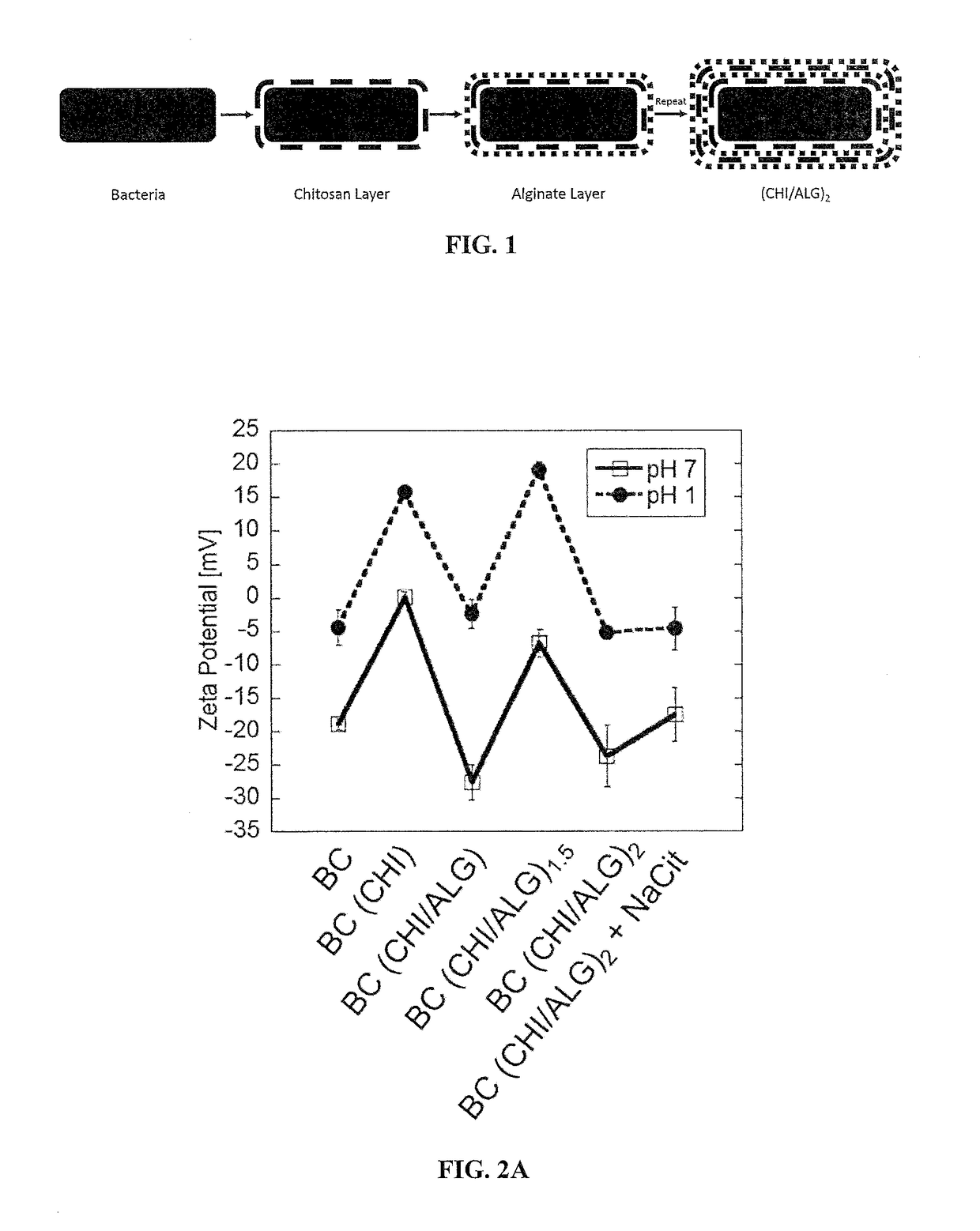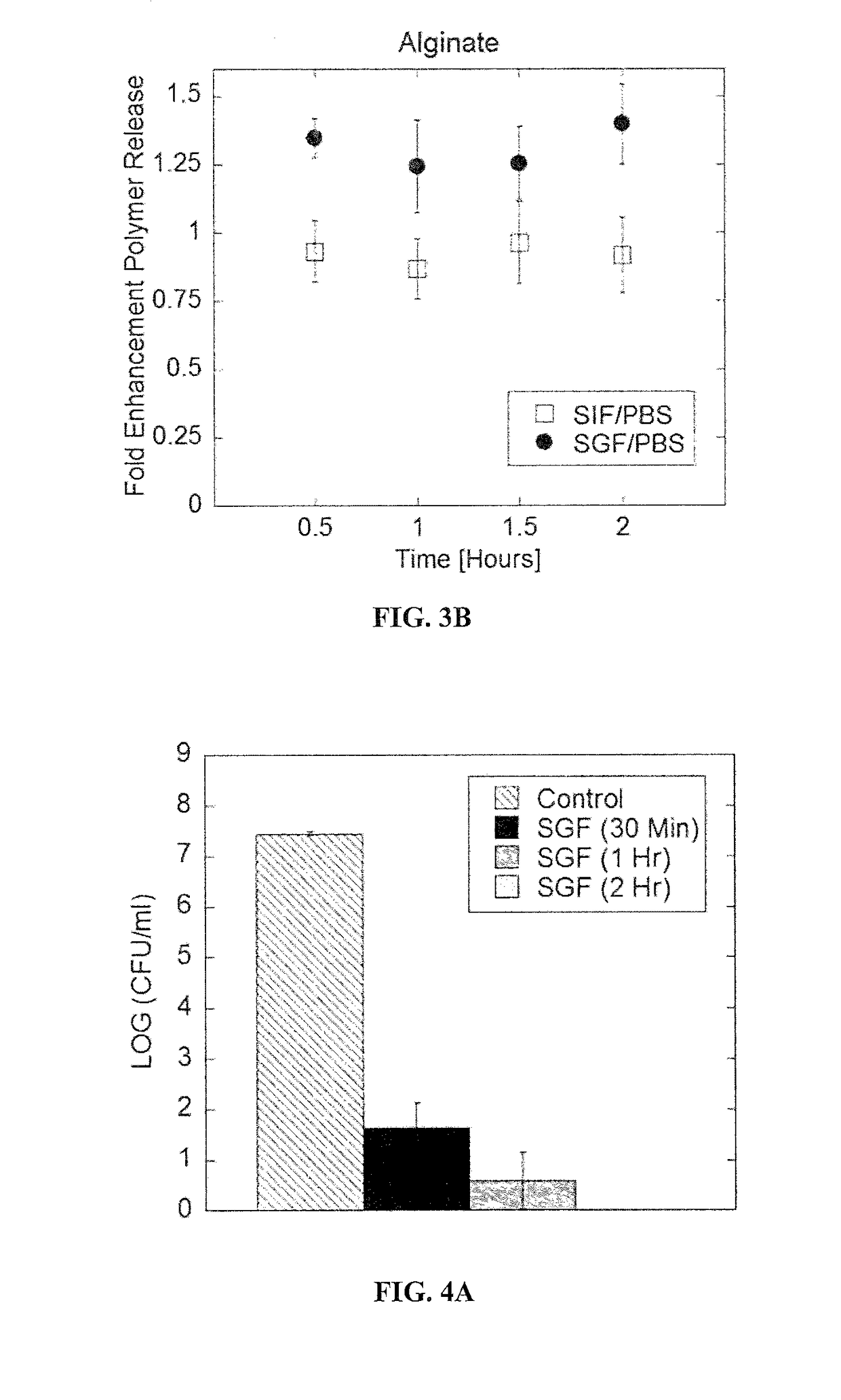Ph-responsive mucoadhesive polymeric encapsulated microorganisms
a polymeric, encapsulated microorganism technology, applied in the direction of microcapsules, antibody medical ingredients, plant/algae/fungi/lichens ingredients, etc., can solve the problems of relatively crude delivery systems and inability to facilitate the control and direct modulation of the gi microbiome, and achieve enhanced retention and viability. prolong
- Summary
- Abstract
- Description
- Claims
- Application Information
AI Technical Summary
Benefits of technology
Problems solved by technology
Method used
Image
Examples
example 1
Layer-by-Layer Templating of Bacillus coagulans
Methods and Materials
[0248]Bacteria Growth
[0249]Bacillus coagulans (ATCC #7050) (“BC”) were grown at 37 C in Difco nutrient broth and on Difco nutrient agar (VWR) and used for all experiments and stored while in the exponential phase. Counting of bacteria was performed using the standard plate counting method streaked with glass beads, where all plates had between 30-100 colonies. Prior to plating, all formulations were first resuspended and washed twice in PBS. For IVIS experiments, bacteria were stained with vivotag-S 750 (20 μl of a 10 mg / ml vivotag-S 750 in DMSO in 5 mg of bacteria in 980 μl of pH 8.5 210 mM bicarbonate buffer) under rotation at room temperature for 1 hour.
[0250]BC, either plain or encapsulated, were grown under shaking conditions (225 RPM) at 37° C. using an INNOVA® 44 incubating shaker. OD600 readings were obtained using a SPECTRAMAX® Plus 384 spectrophotometer with media-only backgrounds subtracted. In the case ...
example 2
Layer Stability in Simulated Intestinal Fluid and Simulated Gastric Fluid
Methods and Materials
[0261]As described in Example 1.
Results
[0262]2-bilayer of chitosan and alginate templated on Bacillus coagulans remained stable under physiologically relevant conditions (FIGS. 3A and 3B). This result suggests that layers will not be readily removed or destroyed due to conditions typically encountered in the GI tract.
example 3
Layer-by-Layer Templating Protects Encapsulated Probiotics Against Biological Insults
Methods and Materials
[0263]Probiotic Response to Insults
[0264]Plain or LbL-coated Bacillus coagulans were subjected to either 4% bile salt solution (Sigma) or SGF (Bicca) in a water bath at 37 C for up to 2 hours. After 2 hours, bacteria were pelleted at 3000 g and resuspended and washed twice in PBS. Bacteria were plated in sequential dilutions of ten and allowed to grow for at least 48 hours at 37 C, and counted as described in Example 1.
Results
[0265]LbL-probiotics resisted acid and bile salt insults. Non-modified Bacillus coagulans exhibited rapid decrease in viability (colony forming units) in both simulated gastric fluid (SGF) and 4% bile salts (FIGS. 4A-4B). 2-bilayers of chitosan and alginate protected against biological insults. LbL-coating of (CHI / ALG)2 provided protection to Bacillus coagulans against SGF and bile salts (FIG. 4C). LbL-formulated (CHI / ALG)2 Bacillus coagulans were protected...
PUM
| Property | Measurement | Unit |
|---|---|---|
| Fraction | aaaaa | aaaaa |
| Time | aaaaa | aaaaa |
| Composition | aaaaa | aaaaa |
Abstract
Description
Claims
Application Information
 Login to View More
Login to View More - R&D
- Intellectual Property
- Life Sciences
- Materials
- Tech Scout
- Unparalleled Data Quality
- Higher Quality Content
- 60% Fewer Hallucinations
Browse by: Latest US Patents, China's latest patents, Technical Efficacy Thesaurus, Application Domain, Technology Topic, Popular Technical Reports.
© 2025 PatSnap. All rights reserved.Legal|Privacy policy|Modern Slavery Act Transparency Statement|Sitemap|About US| Contact US: help@patsnap.com



